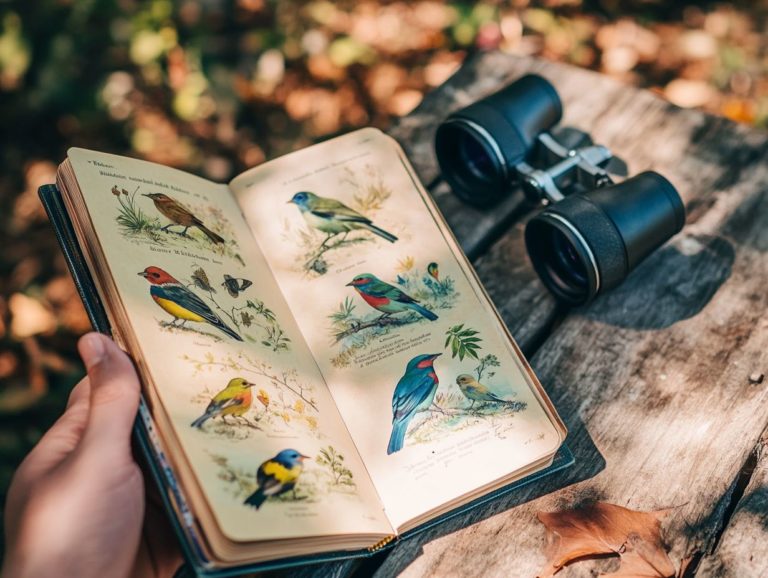Creating Your Own Birding Field Guide
Birdwatching offers a wonderful opportunity to connect with nature. The right field guide can significantly enrich your experience.
In this article, you’ll explore the essentials of birding field guides from choosing the ideal one to grasping the critical information it should encompass, such as species identification and habitat descriptions.
If you’re feeling adventurous, we ll walk you through the steps to create your own custom guide. You ll also discover tips and tricks designed to elevate your birding skills.
Whether you’re just starting or have been at it for years, there’s something valuable here for everyone.
Contents
- Key Takeaways:
- Choosing the Right Field Guide
- Essential Information in a Field Guide
- Creating Your Own Field Guide
- Tips and Tricks for Effective Birding
- Frequently Asked Questions
- What is a birding field guide?
- Why should I create my own birding field guide instead of buying one?
- What are the essential elements to include in a birding field guide?
- Can I include my own personal observations in my birding field guide?
- Is it possible to create a birding field guide online?
- What are some creative ways to organize a birding field guide?
- Your Birding Field Guide
- What to Include in Your Guide?
- Can You Add Personal Observations?
- Can You Create One Online?
- Creative Organization Ideas
Key Takeaways:

- Choose a field guide that suits your needs and preferences, considering factors like size, content, and regional coverage.
- A comprehensive field guide should include species identification, range maps, and descriptions of behaviors and habitats.
- Create your own personalized field guide by researching and organizing information while using effective birding techniques like observation and record-keeping.
What is a Birding Field Guide?
A Birding Field Guide is an essential companion for you as a birdwatcher. It aids in identifying various bird species through exquisite illustrations, photographs, and thorough descriptions. These guides highlight seasonal variations and physical characteristics, complemented by quick reference sections that cater to both beginners and experienced birders, enriching your birding experience.
With technology at your fingertips, many field guides are available in digital formats or mobile apps, giving you easy access to bird calls and identification features that make birding not just efficient, but truly engaging.
The importance of a Birding Field Guide transcends mere identification; it opens the door to a deeper understanding of diverse bird-related behaviors and habitats. Whether you prefer a traditional printed book or a sleek mobile app, these guides offer valuable insights into migratory patterns, feeding habits, and ecological roles, enhancing your knowledge and appreciation for the birds around you.
Features like interactive maps and user-generated data empower you to track your sightings and contribute to citizen science projects, fostering a profound connection with the natural world. By equipping you with essential information, a well-crafted field guide transforms simple observations into enriching adventures in the great outdoors.
Choosing the Right Field Guide
Selecting the right field guide is essential for elevating your birdwatching experience, especially when you’re focused on spotting specific species like the Common Gull and Northern Shovelers.
Consider factors such as the guide’s comprehensiveness, the availability of regional guides, and its user-friendliness. Each element significantly influences your ability to identify birds and enhances your overall status as a birder, making your choice of guide a critical step in your birding journey.
Factors to Consider
When choosing a field guide, consider several key factors that can elevate your birdwatching experience. Look for a guide that excels in helping you identify birds through detailed illustrations, photos, and field marks. This will make your time in the field exciting and fulfilling!
Ease of use is also crucial; organized information and quick reference sections are essential for documenting your sightings efficiently when you re exploring.
A well-structured layout helps you navigate the guide effortlessly, making it simple to locate specific species or characteristics without wasting precious time. Additionally, habitat descriptions play a vital role by offering insights into where different birds are likely to be found, aiding in accurate and timely identification.
For those moments when you re on the move, portability is essential. Opt for a guide made from lightweight and durable materials, ensuring it can withstand the rigors of outdoor adventures while fitting comfortably in your backpack.
These thoughtful design elements work together to foster a more rewarding birdwatching journey, maximizing your opportunities to engage with the beauty of nature.
Essential Information in a Field Guide
Essential information in a field guide includes several key components crucial for successful birdwatching, such as species identification, range maps, and detailed descriptions of behavior and habitat.
This information not only assists you in recognizing various species but also deepens your understanding of the environment and the roles birds play within it.
Visual aids further streamline the identification process, making it even easier for you to connect with the avian world around you.
Species Identification
Species identification serves as the cornerstone of your birdwatching experience, giving you the power to accurately recognize and document various bird species by honing in on specific identifying features and field marks.
By understanding these traits, you enhance your birdwatching experience and create a meticulous record of your sightings and personal journaling.
Field guides become essential companions in your quest for knowledge, offering a treasure trove of information that goes beyond mere text to include striking illustrations and photographs. These visual aids spotlight distinguishing characteristics like color patterns, size, and behavior elements that can vary widely between species.
Checking out websites such as the Cornell Lab of Ornithology or resources from the National Audubon Society can significantly elevate your identification process. For many birdwatchers, mastering these field marks transforms into a rewarding challenge, nurturing a profound appreciation for the variety of bird species and the intricate ecosystems they inhabit.
Range Maps

Range maps are your must-have tools in your birding field guide, offering crucial geographic distribution insights that significantly aid you in identifying various bird species throughout their seasonal changes.
These maps give you the power to pinpoint where to find specific birds during their migratory journeys and breeding seasons.
By illustrating both breeding and wintering grounds, range maps enable you to anticipate the presence of certain species year-round. They also reveal essential migratory routes, shedding light on how environmental factors shape avian behavior.
Grasping these geographic distributions can elevate your ability to distinguish between local populations and transient visitors, ultimately enriching your entire birding experience. In essence, these visual aids enhance your field observation skills and deepen your appreciation for the intricate connections among habitat, behavior, and migration in the captivating realm of birds.
Behavior and Habitat Descriptions
Behavior and habitat descriptions in a field guide offer you vital insights into the lifestyles and environments of various bird species, enhancing your overall experience while observing birds in the wild.
By grasping these descriptions, you can better predict behavior patterns and locate birds more efficiently in their natural habitats.
Diving into the specifics of a species’ preferred environments whether wetlands, forests, or grasslands allows you to strategically plan your outings, boosting your chances of encountering a diverse array of avian life.
Familiarizing yourself with factors such as feeding habits, mating rituals, and migratory tendencies gives you the power to align your activities with peak observation periods.
This understanding elevates your birdwatching experience and nurtures a deeper appreciation for the ecological roles these species fulfill.
Thus, the attention you give to behavior and habitat in field guides becomes essential, enabling you to make informed decisions as you embark on your adventures in nature.
Creating Your Own Field Guide
Creating your own birdwatching journal with field guides is a rewarding project for birdwatchers, offering a unique opportunity to document local species in a way that truly reflects your personal experiences.
By skillfully researching and curating information, you can compile essential details that showcase your discoveries and capture the essence of your individual birdwatching journey.
Researching and Gathering Information
Researching and gathering information is your foundational step in creating a field guide that accurately captures the essence of various bird species and their characteristics. As a birdwatcher, you should leverage visual aids, online databases, and understanding bird identification with field guides to collect detailed data that enrich the quality and depth of your personalized guides.
This journey can be significantly enhanced by connecting with local groups that study birds, which often provide invaluable insights and resources. Using apps that track bird sightings will offer you real-time data, deepening your understanding of behavioral patterns and migration.
By blending these digital tools with traditional methods like visiting libraries for books about birds or consulting field experts you ensure a well-rounded approach. Incorporating photographs, diagrams, and charts can further highlight the unique features of each bird species, making your guide not only informative but also visually captivating for readers.
By integrating both modern and classic resources, you can craft a field guide that truly embodies the rich diversity of avian life.
Organizing and Designing the Guide
Organizing and designing your field guide is essential for making it user-friendly and accessible for birdwatchers on the go. By carefully categorizing information and employing a logical layout, you can create a guide that facilitates quick referencing and enhances your birdwatching adventures, especially when exploring bird habitats with field guides.
The layout you choose significantly influences how you navigate through various species, habitats, and behaviors. Using visuals like clear photographs or illustrations boosts comprehension, while a systematic categorization whether by color, size, or geographic region enables swift identification in the field.
Adding features like quick-reference tabs or indexed sections not only enhances usability but also elevates your overall birdwatching experience. This careful design turns your guide into an essential tool for birdwatchers, whether they re casual observers or seasoned ornithologists.
Tips and Tricks for Effective Birding
To elevate your birdwatching experience, consider employing a variety of tips and tricks that can greatly enhance your skills in observing birds within their natural habitats. These strategies assist you in identifying diverse species and enrich your adventures, creating lasting memories as you connect with nature.
Observation Techniques

Effective observation techniques are essential to your birdwatching success, giving you the power to identify birds with precision and truly appreciate their behaviors. By using tools like binoculars and honing skills such as recognizing bird calls, you can significantly elevate your overall birding experience.
Integrating these methods transforms birdwatching into a more immersive and rewarding pursuit. For instance, seasoned enthusiasts recommend keeping a field guide close at hand, allowing you to cross-reference features like plumage, size, and flight patterns when you spot a new bird.
This approach boosts your identification accuracy and deepens your appreciation for avian diversity. Beyond visual observation, honing your ability to discern various bird calls and songs opens up vital insights into their habits and habitats.
Regular practice, paired with keeping notes in a bird journal, can refine these techniques even further. This not only helps you track your progress but also enables you to witness the gradual unfolding of your ornithological knowledge.
Start applying these tips today to make your next birdwatching adventure unforgettable!
Record-Keeping and Note-Taking
Record-keeping and note-taking are essential for birdwatchers. They help you maintain sighting logs and a developing birding journal.
By documenting your observations, you can track your experiences and share your findings. This contributes to personal growth and community knowledge about various bird species.
These practices deepen your understanding of bird behavior and play a vital role in conservation efforts by providing valuable data for studies.
Boost the quality of your records! Use effective documentation techniques dedicate specific sections to date, location, weather conditions, and species details.
Incorporating sketches or photographs alongside your written notes can further enhance the richness of your logs.
Using digital tools or specialized apps designed for birdwatching can streamline your documentation process. This ensures that no detail escapes your attention.
This approach fosters a deeper connection with nature and promotes informed decisions regarding conservation efforts.
Frequently Asked Questions
What is a birding field guide?
A birding field guide helps you identify birds with illustrations and information about different species.
Why should I create my own birding field guide instead of buying one?
Creating your own birding field guide allows you to customize it to your needs. You can include only the birds you are interested in and add your own notes by following this guide on how to create a personalized bird field guide.
What are the essential elements to include in a birding field guide?
A birding field guide should include clear illustrations or photographs, information on size, color, habitat, behavior, and calls. It should also cover range and migration patterns, tips for identifying similar species, and a glossary of birding terms.
Can I include my own personal observations in my birding field guide?
Yes! Adding your own notes and observations is one of the advantages of creating your own guide. It helps remember specific behaviors or characteristics of a bird.
Is it possible to create a birding field guide online?
Absolutely! Several online tools and websites allow you to create and customize your own birding field guide, and you can enhance your experience with field guides that build your birdwatching knowledge. Some even offer the option to print a physical copy.
What are some creative ways to organize a birding field guide?
Start your birding adventure today! Document your sightings and explore the wonders of nature.
Your Birding Field Guide
Organize your birding field guide by geographical region, color, or family. Consider using field guides: navigating the world of birds to add tabs or bookmarks for quick reference, along with fun facts about each species!

Create a personalized birding field guide to suit your interests. You can include your favorite birds, add notes, and organize your bird field guides in a way that works best for you.
What to Include in Your Guide?
Include clear images of the birds. Add details about their size, color, habitat, behavior, and sounds.
Don’t forget information about their locations and seasonal movements. Tips for identifying look-alikes are also helpful!
Can You Add Personal Observations?
Absolutely! Adding your notes can help you remember unique behaviors or traits that other guides might miss.
Can You Create One Online?
Yes! Many online tools let you create and customize your own birding field guide, and there are resources that explain how to choose the right bird field guide. Some even print physical copies for you!
Creative Organization Ideas
Think about organizing your guide in fun ways, like by region or color. Get creative with bookmarks and tabs!






